Slap Yo’ Daddy Texas-Style Beef Brisket
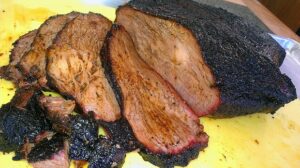
Prep time
Cook time
Total time
When you’re in North Carolina and you ask for barbecue, you’ll get pulled pork with vinegar sauce. When you’re in Kansas City, you’ll get sweet pork spareribs. When in Memphis, it’s dry or wet tangy sweet baby-back ribs. When in California, you’ll get salty garlicky beef tri tip. When in Texas, you’ll get Texas-style brisket.
In my travels across the barbecue states I’ve always been impressed by the diverse barbecue traditions and styles of this only true and authentic American food. During the 2012 Christmas break I had a great time eating my way through over a dozen barbecue joints in Austin, Texas]. I wanted to return to Texas as that was where my first blush with American barbecue began when I arrived in Lubbock, Texas, as an international student in the early 1980’s to attend Texas Tech University. My classmate took me out for some brisket and I fell in love with Texas-style barbecue brisket. Brisket in Texas has a distinctive smokey, salty, and peppery flavor that will melt in your mouth and transport you to beef heaven. That experience left an unforgettable memory and I spent the next 20 years trying to replicate that magical first bite.
As a professional pitmaster since 2008, I’ve cooked my fair share of first place briskets in KCBS, IBCA, and PNWBA sanctioned contests. In 2010, I was pleasantly surprised that I won first place in the nation in the 2010 KCBS Ranchers Reserve Brisket Cup Grand Championships. My 2012 trip to Austin rekindled my taste buds for Texas-style beef brisket which is quite different than the briskets I’ve cooked and won on the West Coast (CA, AZ, NV) contest circuit. For example, I’ve done well on the West Coast by saucing my brisket but I suspect the practice would be frowned upon in Texas as I did not taste any sauce on briskets during my Austin barbecue crawl. I’ve also notice that the California flavor profile leans towards spicy flavors while Texas has more peppery nuances.
In this article, I share my version of a Texas-style brisket recipe which uses no brisket injection. Instead of aluminum foil, the brisket is wrapped in pink butcher paper which seems to be a page (pun intended) taken from the French en papillote technique of cooking in parchment paper. When I talked to pitmasters in Texas about their use of butcher paper, I got the impression that they felt butcher paper was superior to aluminum foil as it allowed the brisket to “breathe” better. This resulted in a crust that was crispier than the somewhat soggy crust resulting from foiling. Also, the oil from the brisket coats the paper and forms and water tight seal so the juices don’t leak out. The butcher paper also minimizes over-smoking and also helps to keep the brisket moist.
Whether you use regular brown or white butcher paper is up to you but I went the extra mile to order pink butcher paper from Amazon.com because I wanted to stay true to the Texas technique. Trimming is also minimal as it’s common to serve the charred beef fat with the brisket meat. You can ask for lean which is the flat slice with the fat cap attached or the fatty brisket which is the point with the fatty bits attached.
There is a special searing phase in my recipe where you char the fat to get that special Texas brisket flavor. Regardless of which cuts you prefer, the Texas-style brisket is always smokey, salty, and delicious!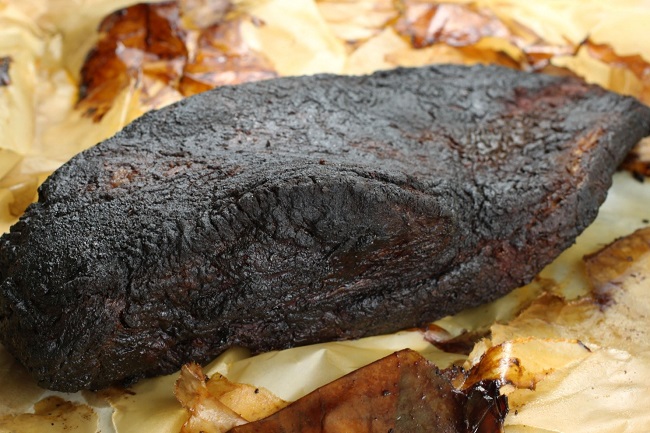 It should look charred like a meteorite.
It should look charred like a meteorite.
In my travels across the barbecue states I’ve always been impressed by the diverse barbecue traditions and styles of this only true and authentic American food. During the 2012 Christmas break I had a great time eating my way through over a dozen barbecue joints in Austin, Texas]. I wanted to return to Texas as that was where my first blush with American barbecue began when I arrived in Lubbock, Texas, as an international student in the early 1980’s to attend Texas Tech University. My classmate took me out for some brisket and I fell in love with Texas-style barbecue brisket. Brisket in Texas has a distinctive smokey, salty, and peppery flavor that will melt in your mouth and transport you to beef heaven. That experience left an unforgettable memory and I spent the next 20 years trying to replicate that magical first bite.
As a professional pitmaster since 2008, I’ve cooked my fair share of first place briskets in KCBS, IBCA, and PNWBA sanctioned contests. In 2010, I was pleasantly surprised that I won first place in the nation in the 2010 KCBS Ranchers Reserve Brisket Cup Grand Championships. My 2012 trip to Austin rekindled my taste buds for Texas-style beef brisket which is quite different than the briskets I’ve cooked and won on the West Coast (CA, AZ, NV) contest circuit. For example, I’ve done well on the West Coast by saucing my brisket but I suspect the practice would be frowned upon in Texas as I did not taste any sauce on briskets during my Austin barbecue crawl. I’ve also notice that the California flavor profile leans towards spicy flavors while Texas has more peppery nuances.
In this article, I share my version of a Texas-style brisket recipe which uses no brisket injection. Instead of aluminum foil, the brisket is wrapped in pink butcher paper which seems to be a page (pun intended) taken from the French en papillote technique of cooking in parchment paper. When I talked to pitmasters in Texas about their use of butcher paper, I got the impression that they felt butcher paper was superior to aluminum foil as it allowed the brisket to “breathe” better. This resulted in a crust that was crispier than the somewhat soggy crust resulting from foiling. Also, the oil from the brisket coats the paper and forms and water tight seal so the juices don’t leak out. The butcher paper also minimizes over-smoking and also helps to keep the brisket moist.
Whether you use regular brown or white butcher paper is up to you but I went the extra mile to order pink butcher paper from Amazon.com because I wanted to stay true to the Texas technique. Trimming is also minimal as it’s common to serve the charred beef fat with the brisket meat. You can ask for lean which is the flat slice with the fat cap attached or the fatty brisket which is the point with the fatty bits attached.
There is a special searing phase in my recipe where you char the fat to get that special Texas brisket flavor. Regardless of which cuts you prefer, the Texas-style brisket is always smokey, salty, and delicious!
 It should look charred like a meteorite.
It should look charred like a meteorite.Author: Harry Soo
Recipe type: Entree
Cuisine: American
Serves: 6 to 8
Ingredients
- 1 Angus Choice Grade packer brisket, about 15 lbs (packer means the point and flat muscles are attached)
- 3 tablespoons beef paste (Tones Beef Base brand)
- 3 tablespoons Worcestershire sauce
- Rub 1 – combine 3 tablespoons SYD Hot Rub with 1 tablespoon of black pepper and 1 teaspoon of celery seed powder (Rub 1 is much better than Rub 2)
- Or, if you don’t have my SYD Hot Rub, mix Rub 2 – combine 3 tablespoons Kosher salt + 1 tablespoon black pepper + 1 tablespoon chili powder, 1 tablespoon granulated garlic + 1 tablespoon sugar
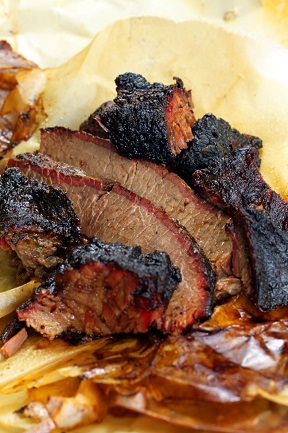
Instructions
- Trim excess fat from all around the brisket including the point, flat, and fat cap. Trim the fat cap so it is only between ¼ to ½ inch maximum thickness
- Mix the beef base with Worcestershire sauce to form a slurry. Slather the mixture all over the brisket including the fat cap
- Sprinkle an even coating of the Rub 1, or Rub 2 if you don’t have my SYD Hot rub available, all over including the fat cap
- Let rest for at least 30 minutes or wrap in cling wrap overnight in the fridge to marinate. Start your pit and get it to 200F
- Put the brisket fat side down in the pit. After about 6 hours and when some bark has begun to form, spray copiously with tap water from a spray bottle.
- Increase the temp to 250°F. Continue to spray every 20 minutes. When the crust has formed all over the brisket (about 2-3 hours later), increase the temp to 300°F for 30 mins to sizzle the bottom fat cap.
- Remove and wrap in pink butcher paper with the fat side down. If you don’t have pink butcher paper, use white butcher paper; else as a last resort, use aluminum foil. If you use aluminum foil, it will give you a wetter and softer crust than the drier crispy Texas pink paper technique
- Lower your pit temp to 250°F and cook until the paper-wrapped brisket it is probe-tender (about another 2-3 hours). I opened the paper pouch and used a thin bamboo skewer to check for tenderness.
- Remove at the level of doneness and tenderness you like.
- Open the paper pouch to vent the excess steam. Allow to rest until the internal temp is 170°F when measured by an instant read thermometer.
- Spoon the au jus onto the top of the brisket before you cut into pencil-thick slices. Serve immediately. Enjoy!
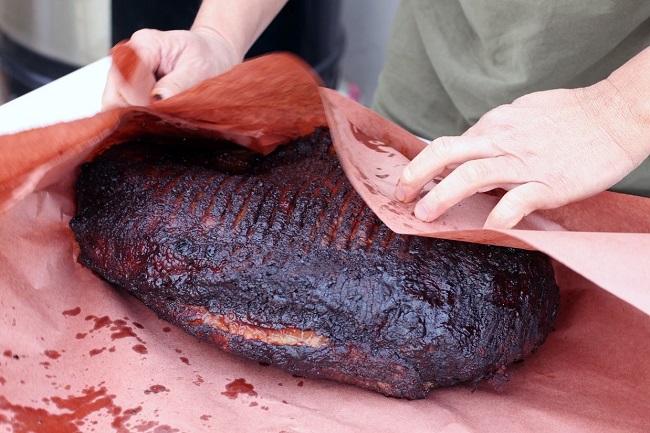 Wrapping in pink butcher paper ala Texas-style!
Wrapping in pink butcher paper ala Texas-style! 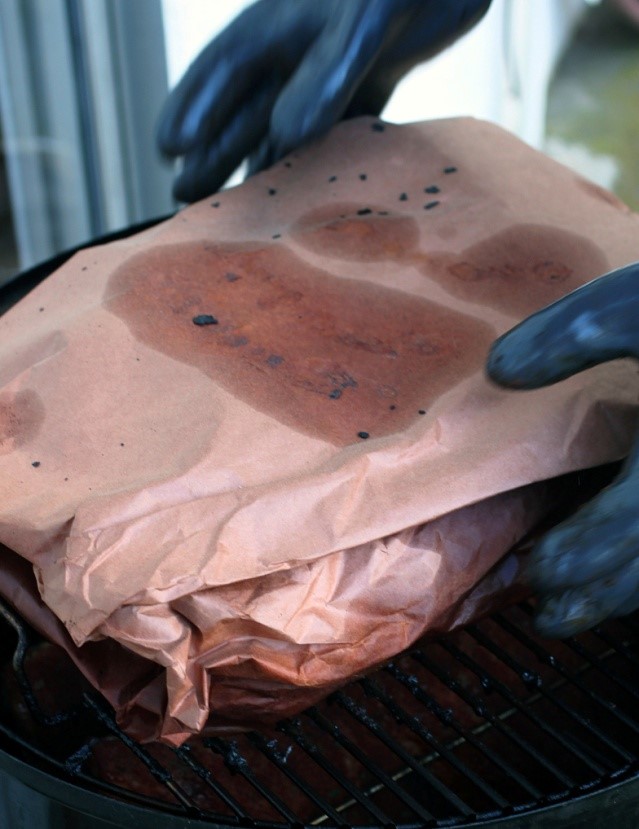 Wrapped brisket going back on pit
Wrapped brisket going back on pit
Recipe by Slap Yo' Daddy BBQ at https://www.slapyodaddybbq.com/2013/09/slap-yo-daddy-texas-style-beef-brisket/